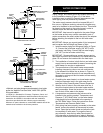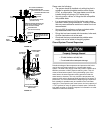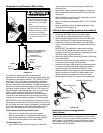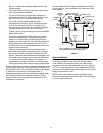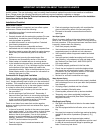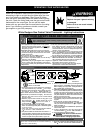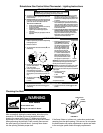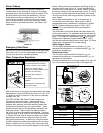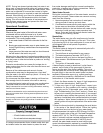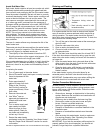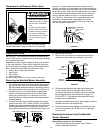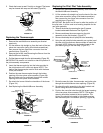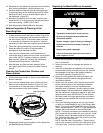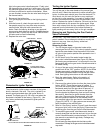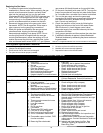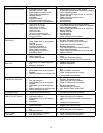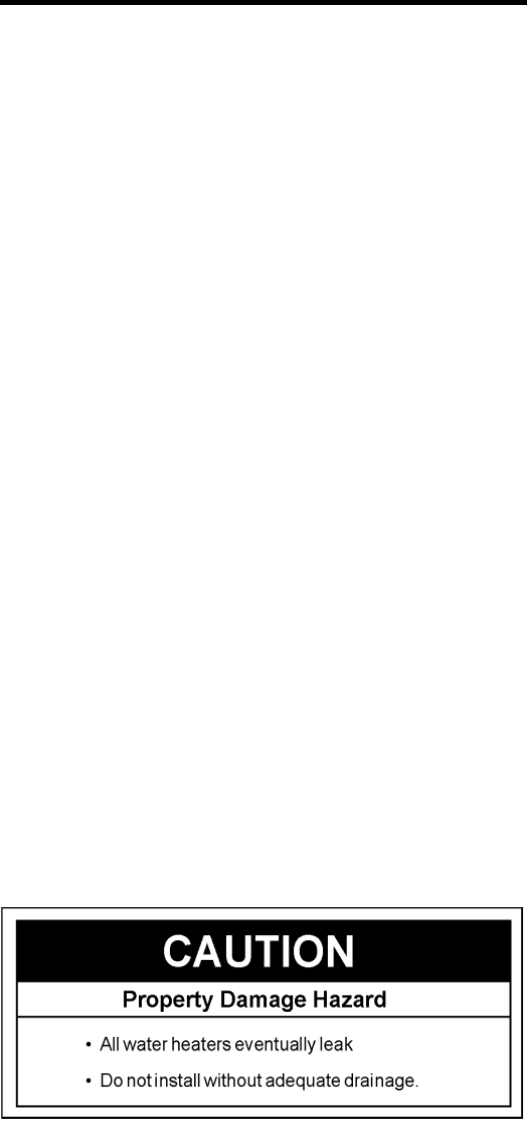
23
from water damage resulting from normal condensation
production, a leaking tank or piping connections. Refer to
the “Location Requirements” section.
Water Heater Sounds
During the normal operation of the water heater, sounds or
noises may be heard. These noises are common and may
result from the following:
1. Normal expansion and contraction of metal parts
during periods of heat-up and cool-down.
2. Condensation causes sizzling and popping within the
burner area and should be considered normal.
3. Sediment buildup in the tank bottom will create varying
amounts of noise and may cause premature tank
failure. Drain and flush the tank as directed under the
“Draining and Flushing” section.
Smoke/Odor
The water heater may give off a small amount of smoke
and odor during the initial start-up of the unit. This is due
to the burning off of oil from metal parts of a new unit and
will disappear after a brief period of operation.
Safety Shut-off
This water heater is designed to automatically shut-off in
the event of the following:
1. The pilot flame is extinguished for any reason.
2. The water temperature exceeds 195°F (91°C).
3. Excessive build up of dust on the base ring filter or
flame arrestor. See Maintenance of your Water Heater
Section.
4. The ignition of flammable vapors.
A thermocouple is used to determine if a pilot flame is
present, and will shut off the gas supply to the main
burner and the pilot if the flame is absent. This unit is
also equipped with a thermal switch, designed to shut off
the gas supply in the event the water heater has been
exposed to flammable vapors (e.g., spilled gasoline),
poor combustion caused by a blocked vent or insufficient
combustion air. If the thermal switch opens:
1. Check the fl ame-arrestor for signs of high temperature
(blue or black discoloration). See Figure 29.
2. If there are signs of high temperature, inspect your
installation for any problems with venting, combustion
air supply and for a fl ammable vapor event (see “Pilot
Light Troubleshooting Flow Chart” section). Correct any
issues prior to resetting the thermal switch. If you suspect
a fl ammable vapor incident has occurred, do not use this
appliance. Immediately call a qualifi ed technician to inspect
the appliance. Water heaters subjected to a fl ammable
vapors ignition will require replacement of the entire water
heater.
3. Reset the thermal switch by depressing the small button
in the center of the thermal switch. Follow the Lighting
Instructions found on the front of your water heater.
A high temperature limit switch or ECO (Energy Cut Off) in
the tank is used to shut off the unit if the water temperature
exceeds 195°F (91°C). The ECO is a single-use switch,
which, if activated, requires complete replacement of the
entire gas control valve/thermostat. If the ECO should
activate, the water heater cannot be used until the gas
control valve/thermostat is replaced by a qualified technician.
Contact your local dealer for service information.
NOTE: During low demand periods when hot water is not
being used, a lower thermostat setting will reduce energy
losses and may satisfy your normal hot water needs. If hot
water use is expected to be more than normal, a higher
thermostat setting may be required to meet the increased
demand. When leaving your home for extended periods
(vacations, etc.) turn the temperature dial to its lowest
setting. This will maintain the water at low temperatures
with minimum energy losses and prevent the tank from
freezing during cold weather.
Operational Conditions
Condensation
Whenever the water heater is filled with cold water, some
condensate will form while the burner is on. A water
heater may appear to be leaking when in fact the water is
condensation. This usually happens when:
a. A new water heater is filled with cold water for the first
time.
b. Burning gas produces water vapor in water heaters, par-
ticularly high efficiency models where flue temperatures
are lower.
c. Large amounts of hot water are used in a short time and
the refill water in the tank is very cold.
Moisture from the products of combustion condense on the
cooler tank surfaces and form drops of water which may fall
onto the burner or other hot surfaces to produce a “sizzling”
or “frying” noise.
Excessive condensation can cause pilot outage due to
water running down the flue tube onto the main burner and
putting out the pilot.
Because of the suddenness and amount of water,
condensation water may be diagnosed as a “tank leak”.
After the water in the tank warms up (about 1-2 hours), the
condition should disappear.
Do not assume the water heater is leaking until there has
been enough time for the water in the tank to warm up.
An undersized water heater will cause more condensation.
The water heater must be sized properly to meet the
family’s
demands for hot water including dishwashers, washing
machines and shower heads.
Excessive condensation may be noticed during the winter and
early spring months when incoming water temperatures are at
their lowest.
Good venting is essential for a gas fired water heater to operate
properly as well as to carry away products of combustion and
water vapor.
It is always recommended that a suitable metal drain pan
be installed under the water heater to protect the area



